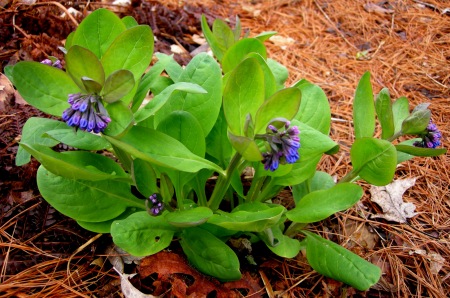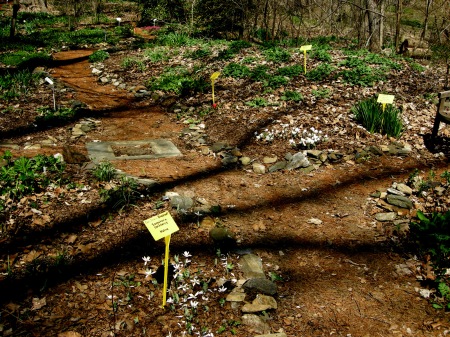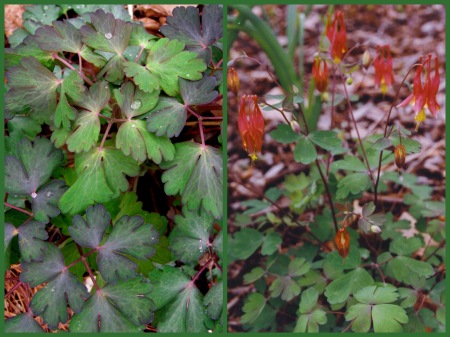 A native white redbud underplanted with natives Virginia bluebells, May apples, and golden groundsel.
A native white redbud underplanted with natives Virginia bluebells, May apples, and golden groundsel.
This is one of my favorites times of the year: our woodland is at its peak and epimediums and emerging hostas fill our side hill. The almost 90 degree weather is moving the plants along quickly, but the native plants in our woodland are glorious right now, and I wanted to capture it on film.
Nursery News: Carolyn’s Shade Gardens is a retail nursery located in Bryn Mawr, PA, specializing in showy, colorful, and unusual plants for shade. The only plants that we ship are snowdrops and miniature hostas. For catalogues and announcements of events, please send your full name, location, and cell number (for back up use only) to carolyn@carolynsshadegardens.com. Click here to get to the home page of our website for catalogues and information about our nursery and to subscribe to our blog.
 Native Celandine poppies under white redbuds.
Native Celandine poppies under white redbuds.
.
 Pine needle paths thread through our woods.
Pine needle paths thread through our woods.
.
 Native Virginia bluebells and Celandine poppies under a ‘Waterfall’ Japanese maple.
Native Virginia bluebells and Celandine poppies under a ‘Waterfall’ Japanese maple.
.
 Native mayapples grow through ‘Alba Plena’ European wood anemone.
Native mayapples grow through ‘Alba Plena’ European wood anemone.
.
 European wood anemones, like ‘Leed’s Variety’, fill in among the native plants in our woods.
European wood anemones, like ‘Leed’s Variety’, fill in among the native plants in our woods.
.
 ‘Leed’s Variety’ European wood anemone
‘Leed’s Variety’ European wood anemone
.
 Pale yellow European wood anemone, Anemone x seemanii.
Pale yellow European wood anemone, Anemone x seemanii.
.
 Some of my favorite native plants make a cameo appearance right now: Tennessee form bloodroot.
Some of my favorite native plants make a cameo appearance right now: Tennessee form bloodroot.
. ‘Multiplex’ double bloodroot blooms for a much longer period than the single flowered forms.
‘Multiplex’ double bloodroot blooms for a much longer period than the single flowered forms.
.
 I let native Dutchman’s breeches seed around wherever it wants to go from our natural woodland to our formal hellebore beds.
I let native Dutchman’s breeches seed around wherever it wants to go from our natural woodland to our formal hellebore beds.
.
 Pulmonarias are another plant that I allow to roam at will in the garden. Their seedlings take many beautiful forms.
Pulmonarias are another plant that I allow to roam at will in the garden. Their seedlings take many beautiful forms.
.
 ‘Jack Frost’ perennial-forget-me-not or brunnera has strikingly beautiful true blue flowers and silver-frosted leaves. Many of its seedings also display silver leaves, and it does very well in the dry shade of our woods.
‘Jack Frost’ perennial-forget-me-not or brunnera has strikingly beautiful true blue flowers and silver-frosted leaves. Many of its seedings also display silver leaves, and it does very well in the dry shade of our woods.
.
 Another plant that does well in dry shade is Japanese woodland primrose. It goes dormant when it gets hot out so doesn’t care about our dry summers.
Another plant that does well in dry shade is Japanese woodland primrose. It goes dormant when it gets hot out so doesn’t care about our dry summers.
.
 Cowslip primroses are also not picky and grow at the edge of our woods in average soil.
Cowslip primroses are also not picky and grow at the edge of our woods in average soil.
.
 ‘Old Brick Reds’ primrose with white bleeding-hearts and native Celandine poppy.
‘Old Brick Reds’ primrose with white bleeding-hearts and native Celandine poppy.
.
 Grecian windflower is a startling shade of blue and seeds through our woods.
Grecian windflower is a startling shade of blue and seeds through our woods.
.
 Delicate rue anemone prefers to grow in the rocks along our woodland paths.
Delicate rue anemone prefers to grow in the rocks along our woodland paths.
.
 The extreme heat has forced our amazing ‘Black Tulip’ magnolia to the end of its bloom period. However, there are a lot of wonderful plants coming into their own right now.
The extreme heat has forced our amazing ‘Black Tulip’ magnolia to the end of its bloom period. However, there are a lot of wonderful plants coming into their own right now.
.
If you are local, I hope you can stop by tomorrow, Saturday, May 5, by appointment to shop and see our gardens, especially the woodland, in person. Just send an email requesting an appointment with some convenient times.
Carolyn
.
Nursery Happenings: You can sign up to receive catalogues and emails about nursery events by sending your full name, location, and phone number to carolyn@carolynsshadegardens.com. Subscribing to my blog does not sign you up to receive this information. Please indicate if you will be shopping at the nursery or are mail order only.
Carolyn’s Shade Gardens is a local retail nursery in Bryn Mawr, Pennsylvania, U.S., zone 6b/7a. The only plants that we mail order are snowdrops and miniature hostas and only within the US.
Facebook: Carolyn’s Shade Gardens has a Facebook Page where I post single photos, garden tips, and other information that doesn’t fit into a blog post. You can look at my Facebook page here or click the Like button on my right sidebar here.
Notes: Every word that appears in orange on my blog is a link that you can click for more information. If you want to return to my blog’s homepage to access the sidebar information (catalogues, previous articles, etc.) or to subscribe to my blog, just click here.





















































